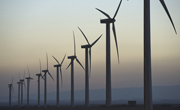Egypt: Renewable Energy and Clean Transport

Egypt’s greenhouse gas emissions have been among the fastest growing in the world, but the country plans to reverse that trend with the help of the recently established Clean Technology Fund aimed at scaling up low-carbon technologies and energy efficiency.
Egypt is among the first countries to tap the $5.2 billion fund currently supported by eight governments, managed by the World Bank, and administered through the World Bank Group and other multilateral development banks.
Egypt plans to use $300 million in concessional financing from the fund, blended with financing from the World Bank Group, the African Development Bank, bilateral development agencies, private sector and other sources to spur wind power development and introduce clean transport options-enabling the country to meet its target of 20 percent of energy from renewable sources by 2020.
Under business-as-usual conditions, Egypt could face a 50 percent increase in greenhouse gas emissions from 2007 levels in the electricity sector alone. Electricity and transport contribute over 70 percent of the greenhouse gas emissions in the country.
But Egypt- considered a leader in the region on renewable energy and energy efficiency-hopes to change that scenario by realizing a 7200 MW wind power capacity by 2020, cutting vehicle emissions in heavily populated regions through improved public transportation systems and making industry more energy efficient.
Egypt is also a participant in a proposed CTF co-financed regional program to scale up concentrating solar power plants in the Middle East and North Africa (MENA).
From a global perspective, it is critical that the best solar resources are used for solar scale-up and MENA region offers this opportunity, says Jonathan Walters, transport and energy manager for the World Bank’s Middle East and North Africa region. Egypt is piloting a small scale concentrating power plant with support from the Global Environment Facility and Japan Bank for International Cooperation.
’Excellent Potential for Wind Power’
On wind energy, “high and persistent” winds in the Gulf of Suez suggest Egypt has “excellent potential for wind power - among the best in the world,” says Walters.
The government and partners such as IFC of the World Bank Group have already financed 400 megawatts of wind-energy capacity. Another 600 megawatts of projects are in the pipeline and expect to start in the next two to four years.
But further development has so far been constrained by lack of infrastructure. For that reason, the government plans to use $100-$120 million in Clean Technology Fund money to co-finance a high-capacity transmission system from the wind farms in the Gulf of Suez to serve heavily populated areas such as Cairo.
Without CTF financing, such infrastructure development could be delayed three to five years, according to the CTF Investment Plan for Egypt.
The funding “is quite game-changing for them,” says Walters. “It comes with co-financing from the Multilateral Development Banks (MDBs) that include World Bank, the African Development Bank and the IFC. Putting $300 million of concessional financing into the mix overall is quite a significant subsidy for investments that have a substantial impact on reducing greenhouse gas emissions.”
Eng. Abdel Rahman, Chairman of Egypt’s National Renewable Energy Agency (NREA), says the CTF will alleviate some of the financial burden of higher renewable energy prices, especially in light of current low prices of oil.
“The CTF is a strong support tool for developing countries with a serious plan to expand renewable energy, and it is even more effective in these times of financial crisis,” says Rahman.
“The CTF supports those countries that are still backing the renewable energy plans they set forth. It also supports availing infrastructures, such as transmission lines that make scaling up of RE possible, and gives confidence to investors to invest in RE in the region.”
Cleaner, Less Congested Urban Transport Planned
Likewise, CTF funds, combined with World Bank financing, will accelerate Egypt’s urban transport plans, including light rail and bus rapid transit development expected to accommodate 5 million passengers daily in Greater Cairo.
Half of Egypt’s vehicles operate in the area and account for 20 million motorized person trips a day and about 13 million tons of CO2 a year. The economic and environmental costs of the megacity’s pollution and traffic congestion have been considerable, says Walters.
To alleviate traffic and reduce CO2 emissions by about 1.5 million tons a year, the government is planning six new bus rapid transit corridors in Cairo, and light rail transit to connect Cairo with fast-growing suburbs.
The plan also calls for replacing 613 old and polluting public minibuses with 1,310 large clean technology buses.
![]()
Multimedia


